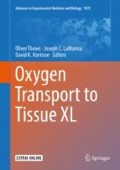Abstract
Impaired oxygen utilization in skeletal muscle potentially contributes to muscle weakness in patients with malignant hematopoietic disease and may explain altered hemodynamic responses to exercise in these patients. We investigated whether changes in hemoglobin parameters in the tibialis anterior muscle in patients with malignant hematopoietic diseases were different from those in age-matched healthy controls and whether these results were associated with a decline in muscle strength. Near-infrared spectroscopy was used during and after a repeated isometric contraction task at 50% of maximal voluntary contraction in 16 patients and 21 age- and sex-matched healthy controls. In the healthy control group, there was a correlation between muscle strength and hemoglobin dynamics, (ΔtHbmean: r = 0.42, p < 0.05; ΔtHbmax: r = 0.575, p < 0.01, respectively) but not in patients with malignant hematopoietic disease. The results of this study may suggest that haemoglobin dynamics during and following exercise were different between patients with malignant hematopoietic disease and healthy controls.
Access this chapter
Tax calculation will be finalised at checkout
Purchases are for personal use only
References
Jarden M, Baadsgaard MT, DJ Hovgaard E et al (2009) A randomized trial on the effect of a multimodal intervention on physical capacity, functional performance and quality of life in adult patients undergoing allogeneic SCT. Bone Marrow Transplant 43:725–737. https://doi.org/10.1038/bmt.2009.27
Wiskemann J, Dreger P, Schwerdtfeger R et al (2011) Effects of a partly self-administered exercise program before, during, and after allogeneic stem cell transplantation. Blood 117:2604–2613. https://doi.org/10.1182/blood-2010-09-306308
Hamaoka T, McCully KK, Quaresima V et al (2007) Near-infrared spectroscopy/imaging for monitoring muscle oxygenation and oxidative metabolism in healthy and diseased humans. J Biomed Opt 12(6):062105. https://doi.org/10.1117/1.2805437
Ferrari M, Muthalib M, Quaresima V (2011) The use of near-infrared spectroscopy in understanding skeletal muscle physiology: recent developments. Philos Trans A Math Phys Eng Sci 369(1955):4577–4590. https://doi.org/10.1098/rsta.2011.0230
Tachi M, Kouzaki KH et al (2004) The influence of circulatory difference on muscle oxygenation and fatigue during intermittent static dorsiflexion. Eur J Appl Physiol 91:682–688. https://doi.org/10.1007/s00421-003-1024-y
Morishita S, Kaida K, Yamauchi S et al (2013) Gender differences in health-related quality of life, physical function and psychological status among patients in the early phase following allogeneic haematopoietic stem cell transplantation. Psychooncology 22(5):1159–1166. https://doi.org/10.1002/pon.3128
Morishita S, Kaida K, Yamauchi S et al (2015) Early-phase differences in health-related quality of life, psychological status, and physical function between human leucocyte antigen-haploidentical and other allogeneic haematopoietic stem cell transplantation recipients. Eur J Oncol Nurs 19(5):443–450. https://doi.org/10.1016/j.ejon.2015.02.002
Morishita S, Kaida K, Yamauchi S et al (2013) Relationship between corticosteroid dose and declines in physical function among allogeneic hematopoietic stem cell transplantation patients. Support Care Cancer 21(8):2161–2169. https://doi.org/10.1007/s00520-013-1778-7
Morishita S, Kaida K, Tanaka T et al (2012) Prevalence of sarcopenia and relevance of body composition, physiological function, fatigue, and health-related quality of life in patients before allogeneic hematopoietic stem cell transplantation. Support Care Cancer 20(12):3161–3168. https://doi.org/10.1007/s00520-012-1460-5
Acknowledgments
This study was supported by the Japan Society for the Promotion of Science (KAKENHI [17H00696]).
Author information
Authors and Affiliations
Editor information
Editors and Affiliations
Rights and permissions
Copyright information
© 2018 Springer International Publishing AG, part of Springer Nature
About this chapter
Cite this chapter
Wakasugi, T. et al. (2018). Hemoglobin Dynamics in the Skeletal Muscle of Patients with Malignant Hematopoietic Disease. In: Thews, O., LaManna, J., Harrison, D. (eds) Oxygen Transport to Tissue XL. Advances in Experimental Medicine and Biology, vol 1072. Springer, Cham. https://doi.org/10.1007/978-3-319-91287-5_46
Download citation
DOI: https://doi.org/10.1007/978-3-319-91287-5_46
Published:
Publisher Name: Springer, Cham
Print ISBN: 978-3-319-91285-1
Online ISBN: 978-3-319-91287-5
eBook Packages: Biomedical and Life SciencesBiomedical and Life Sciences (R0)

